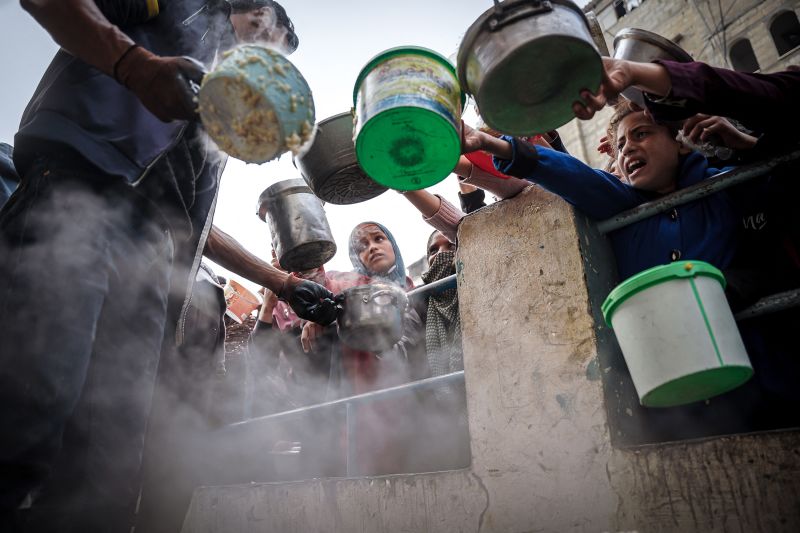Palestinians displaced inside Gaza as Israel pushes on with its ground offensive describe cramped living conditions, sky-high prices for food, children going hungry and poor sanitation, amid severe limits on food and supplies entering the coastal strip.
“The way I am getting by is by begging here and there and taking help from anyone,” said Abu Misbah, a 51-year-old building worker trying to support a family of 10.
Vegetables and fruit were unaffordable, he said. His children asked for oranges, but he was not able to buy them.
“We never [been] through this situation before; we were a middle-class family,” he said. “Now since the war we are buying dates which we used to find everywhere for free. We want a solution to our miserable suffering.”
He, like most others in blockaded Gaza, face what aid groups warn is a looming famine. The entire population of Gaza has already been classified in a state of crisis, according to the Integrated Food Security Phase Classification (IPC).
Israel closed its border with Gaza and launched an intensive bombing campaign in response to Hamas’ October 7 attacks, followed by an ongoing ground invasion. The fighting has triggered a humanitarian crisis throughout the Palestinian territory, forcing thousands from their homes.
This week Israel expanded its operation further into southern Khan Younis, warning residents to leave. But the United Nations says Gazans have nowhere safe to go.
‘What kind of life is this?’
Umm Omar, 50, is also displaced in Rafah, and lives in a tent with her family. During the truce, they had briefly returned home only to find all the windows and solar panels broken, and the kitchen destroyed.
“We are nine people in a tent of two meters by one meter,” she said. “We have bought this camping tent ourselves; no-one helped us or provided it.”
Omar said they were getting by on canned food and estimated that most foods were at least four times as expensive as before the war. Medication is also hard to find.
Mahmoud Harara used to make a living selling produce from a cart. Now the 47-year old, from Al-Shujaiya, is also in Rafah, living with eight family members in the streets, including five school-age children.
“My house was destroyed and two of my sons injured from a strike of our home,” he said.
Like thousands of others, the family live in a makeshift tent made of nylon and roam the streets for food. They left home without any belongings and had no mattresses for the tent. Harara said his family was receiving no help, and the price of food was “beyond imagination…Your child asks you for a piece of bread and you can’t provide that for them. What kind of life is this?”
Harara said he walks three kilometers to a hospital to be able to use toilets. The lack of sanitation for the displaced now packed into parts of southern Gaza has led to the spread of contagious and respiratory diseases.
It was also extremely difficult to access drinking water and his children were cold at nights, he said. None of the family had been able to take a shower in several weeks.
Aid groups warn of famine conditions
In recent days, crowds of civilians desperate for food have been seen surrounding aid trucks coming into Gaza. The United Nations has warned that the humanitarian situation in southern Gaza is deteriorating and warned that the volume of aid entering the enclave “remains woefully inadequate.”
The youngest children in Gaza face high risk of severe malnutrition and preventable death as the risk of famine conditions continues to increase, according to a UNICEF statement last week.
The children’s aid organization estimated that in the coming weeks, “at least 10,000 children under five years will suffer the most life-threatening form of malnutrition, known as severe wasting, and will need therapeutic foods.”
“The threat of dying from hunger is already real” for many families in Gaza, UNICEF added.
An IPC report the same week found that that approximately all of Gaza’s 2.2 million residents are now facing acute hunger and the entire population of the Gaza Strip is classified in a state of crisis – the highest share of people facing catastrophic levels of acute food insecurity that the IPC initiative has ever classified.
“Many adults go hungry so children can eat,” IPC reported, saying humanitarian access must be restored throughout the region to enable the rapid delivery of life-saving aid.
The organization added that “the IPC has emphasized that these conditions do not have to persist. Yesterday’s warning of famine in the coming weeks and months can still be averted. But we must act now.”
UN Secretary General Antonio Guterres has repeatedly said that a ceasefire is necessary to deliver aid to Gaza’s population at scale, and has warned of a potential “catastrophe with potentially irreversible consequences” in the making.
“Amid constant bombardment by the Israel Defence Forces, and without shelter or the essentials to survive, I expect public order to break down soon due to the desperate situation, rendering even limited humanitarian assistance impossible,” he said.
